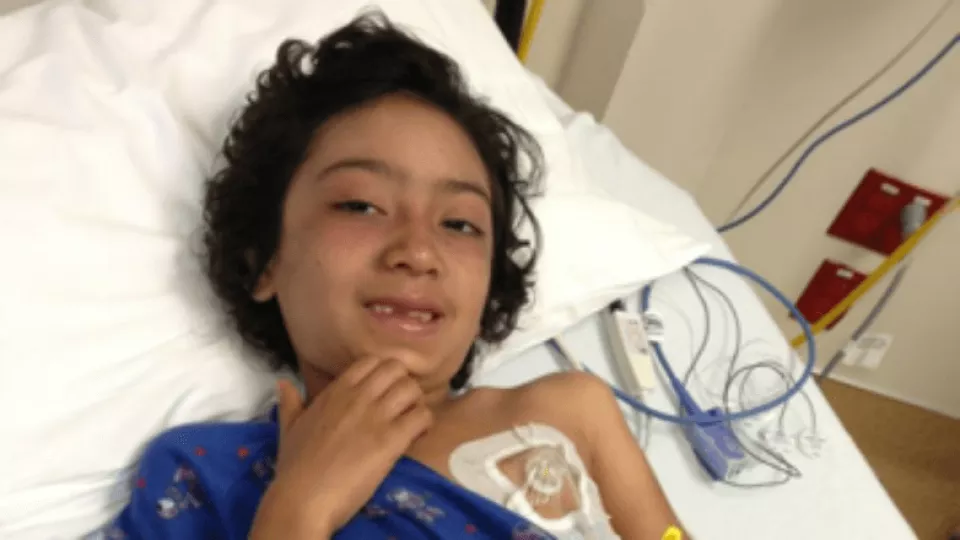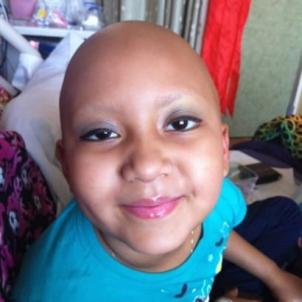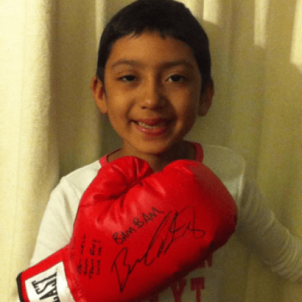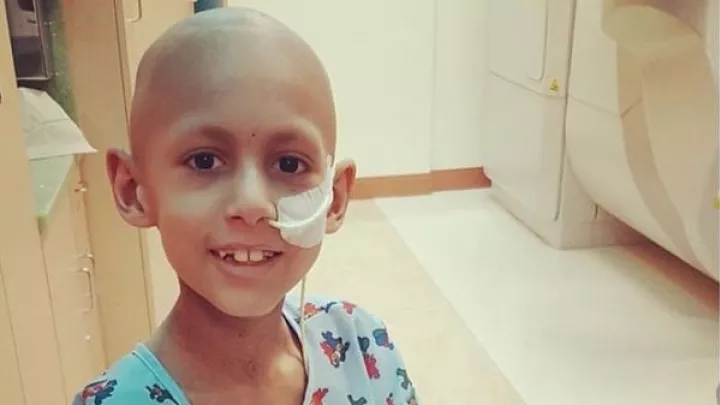
Viviana Beats the Odds—and Leukemia—to Reunite With CHLA Nurses
In May 2011, at her grandmother’s birthday party, Viviana Flores did something nearly unheard of for a 6 year old: She turned down a piece of cake.
She and her mom, Diana Hernandez, had just come from the doctor’s office because Viviana had a stomachache. Her cousin thought Viviana’s face looked a bit green, but the doctor said she was fine. They were told to come back for some tests a few days later if she wasn’t feeling better.
Viviana had also been complaining about pain in her leg, but curiously, it always seemed to come up at bedtime. “As a parent,” says Diana, “sometimes you have to say, ‘Your legs are fine, honey, and yes, you still have to go to bed.’”
The day after her grandma’s birthday, another unusual thing happened: Diana got a call on her cell phone from Viviana’s teacher. “Something’s wrong,” the teacher said. “I don’t know what it is, but you need to come get her. She can’t hold her pencil. It keeps falling through her fingers.”
Diana immediately left work and drove to Viviana’s school, where the district nurse happened to be visiting that day. As the nurse and her teacher were walking Viviana across the lawn, they noticed the little girl was dragging her foot. “Take her to the ER now,” the nurse told Diana.
Diana hurried to the emergency room near their home in Santa Barbara, where she was told her daughter needed a blood transfusion immediately. Viviana was rushed by ambulance to a different hospital, where a biopsy was performed and Viviana was given three bags of blood the first night.
Her red blood cell count was “off the charts,” says Diana, and the doctors knew right away: Viviana had leukemia. “They said if we had waited a day or two she would have died,” Diana recalls.
Just the beginning

A week later when Viviana was discharged, Diana learned that the local hospital was outside of their insurance provider’s network, but within the network she found Children’s Hospital Los Angeles. Diana did some research and discovered that CHLA is one of the best pediatric facilities in the country. “I knew she would be in great hands,” Diana says.
Soon afterward, Viviana met with oncologist Paul Gaynon, MD, from the Children’s Center for Cancer and Blood Diseases at CHLA.
“It was great,” Diana says about the initial consultation. “He explained everything to us.” The plan was to drive Viviana to Los Angeles for her chemotherapy treatments, and in between visits, she received outpatient care from Francisco Bracho, MD, in Ventura.
Viviana’s care team also explained that the chemo would probably make her feel sick and a bit tired. “But I had no idea how tired,” Diana says. “About three weeks into treatment, she wouldn’t wake up. I couldn’t wake her to eat or anything.”
Alarmed, Diana took Viviana back to their local hospital, where she was admitted briefly before being transferred to CHLA. It was early June 2011—just three weeks since her diagnosis.
Viviana had fallen into a coma, in which she would remain for several months, an apparent reaction to the chemotherapy drugs or the pain medication. Her immune system was so weak she initially had to be in isolation, but even that didn’t protect her fragile body. In the months ahead, Viviana would develop pancreatitis; contract a fungal infection; and require treatment from myriad specialists in hematology-oncology, dermatology, infectious disease, gastroenterology, pain management, physical and occupational therapy, and neurology.
“It seemed like whatever complication there could be, Viviana would get it,” her mom says.
As Viviana lay in a coma, the doctors and nurses got to know her by her first name. But it wasn’t until she opened her eyes that they finally got to know her gentle yet feisty personality. In no time, Viviana was playing jokes on her care team at every opportunity.
“When we moved from the old building to the new hospital, I think that’s when she finally woke up—on the other side,” says Diana. “Every doctor who came in would say, ‘Wow! She has such big eyes!’ And I’d laugh and say, ‘That’s right, you never saw her eyes before!’”
Ready to fight
“Move Day” in July 2011 was a carefully orchestrated event, particularly for the 200 critically ill patients—including Viviana—who needed to be transferred from CHLA’s existing hospital facility into the new state-of-the-art Marion and John E. Anderson Pavilion. Many patients could not leave their beds and required teams of clinicians to surround them during the journey to the new building.

Maybe it was the soothing colors, the bright new space or the private room specifically designed for Viviana and her family’s comfort. Whatever the reason, Viviana awoke from the coma and began to regain her strength soon after the move. That’s not to say there weren’t more hurdles to overcome, but Viviana was wide awake and ready to fight.
The coma left her legs badly weakened, so one of the first things she had to do was learn how to walk again. Another major complication was an inflamed pancreas, or pancreatitis, a debilitating side effect of the lifesaving drugs she received in the early phases of chemo. “Pancreatitis is terrible,” Diana says. “She would get attacks and wake up screaming in the middle of the night. She couldn’t eat. She couldn’t do anything.”
Gaynon modified Viviana’s chemo protocol in light of the pancreatitis, which was successfully treated during gall bladder surgery by Quin Liu, MD, director of Gastrointestinal Endoscopy at CHLA. Viviana got stronger as time went by, and in February 2012, she was discharged eight months after being admitted.
Sirinan “Kat” Srilanchanarak, RN, who Diana remembers so tenderly watching over Viviana since her very first night in the hospital, later shared that she was glad she wasn’t there for Viviana’s send-off because she would not have been able to control her emotions to say goodbye.
Finally able to rejoin her mom and four siblings at home, Viviana continued to receive outpatient chemotherapy until her final treatment on Nov. 5, 2014. All told, she underwent chemo for three years until all traces of the leukemia were gone.
“I know a lot of people have big celebrations at the end, and I had hoped to do that, but we were just so exhausted,” says Diana. “We had a quiet dinner at home and a big orange cancer ribbon cake, then we took a deep breath and realized it was over.”
A typical preteen
Viviana now sees Bracho in Ventura for follow-ups and comes to the main campus in Los Angeles for scans. Since her last treatment more than two years ago, Viviana has been cancer-free. She can tire easily when walking more than a short distance—a reminder of the months she spent in a coma—so she is working on strengthening her legs. As for real medical scares since leaving CHLA, there has only been one: a broken collarbone.

“We were actually happy about it because it meant she had the energy to be playing!” Diana says. “Viviana was on a scooter and her brother was on a bike. They were practically riding into each other and daring the other to be the first to move. Viviana won! But she broke her collarbone doing it.”
This past July, at a celebration marking the Anderson Pavilion’s five-year anniversary, Viviana, her mom and three of her four siblings came to CHLA and made a special trip to visit her nurses, who were overcome with joy to see Viviana again.
“It was emotional for all of us,” says Diana. “Viviana had a big smile on her face and she was so happy to see everyone. Walking down the halls, we saw so many familiar faces.”
Now in seventh grade, Viviana is doing well. Her favorite pastimes are playing games on her phone, hanging out at the mall and listening to music. “Definitely a preteen!” says her mom.
Diana is grateful that neither Viviana nor her young siblings are fearful of the hospital. In fact, they love coming back to CHLA for special events, and her family tries to return every time the Blood Donor Center announces a blood or platelet drive.
“When Viviana was sick, and I had to leave her briefly to be home with my other kids, I don’t even know if I can find the words to express my relief when I got back to CHLA,” Diana says. “We always felt a sense of calm here because we knew everything was going to be OK.”


